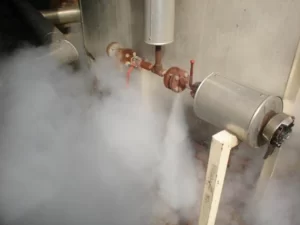
What is a steam trap?
They are valves that were created to discharge condensation and vent air without losing steam. Just like any mechanical item that uses various mechanisms, over time you are going to have increased wear and tear. When this happens you run into a common, yet real problem when your steam trap begins to leak. When steam traps begin to leak wasting energy, affecting production immensely, creating safety issues, and raising your maintenance costs. In order to control a leaking steam trap, you have to be very proactive before the leak gets out of control. Some of the most common reasons for a steam trap leak are dirt, unplanned pressure surges, and oversized traps.
Following these few steps below will help in lessening your chance for a steam leakage
- You want to develop a regular routine and maintenance on the steam trap. Keeping up the checks, and maintenance will find problems before they become too massive. In this step also you are going to want to map out and tag each of the steam traps to make sure everything is being inspected.
- Periodically test your control valves. This is just another part of your maintenance to make sure you are keeping your pressure levels down. Some motors are unable to handle extremely high temperatures and will fail over time. Doing this will help to make sure everything is staying regulated.
- Check the thickness of the piping. Over time the steam and condensate will start to erode your pipes. If your thickness starts to get really low you are going to have cracking, which you guessed it, can start a leak.
- Test your traps using temperature. The inlet and outlet are going to have roughly a 10-degree difference. Performing this test will also tell you if your equipment is capable of handling the overall capacity.
Performing these actions above are just a few items on a checklist that can help maintain your steam trap, and hopefully, prevent a problem before it’s too late.
Save
Save
https://contentupgrade.me/2ypMgB4D
Don’t Waste Energy on Steam Leakage FAQ
1. What is a steam leak?
A steam leak is a loss of steam from a steam system. Steam leaks can occur in pipes, valves, and other components.
2. What are the causes of steam leaks?
The most common causes of steam leaks are:
Loose or damaged gaskets: Gaskets are used to seal joints between pipes and other components. If a gasket is loose or damaged, it can allow steam to leak.
Corrosion: Corrosion can cause pipes and other components to weaken and crack, which can lead to leaks.
Improper maintenance: Improper maintenance, such as not tightening bolts or replacing gaskets, can also lead to leaks.
3. What are the effects of steam leaks?
Steam leaks can have a number of negative effects, including:
Loss of energy: Steam leaks can waste energy, which can lead to higher utility bills.
Safety hazards: Steam leaks can create a safety hazard, as the steam can cause burns or other injuries.
Environmental damage: Steam leaks can release greenhouse gases into the environment, which can contribute to climate change.
4. How can I prevent steam leaks?
There are a number of things you can do to prevent steam leaks, including:
Regularly inspect your steam system: Inspect your steam system for leaks on a regular basis.
Tighten bolts and replace gaskets as needed: Tighten bolts and replace gaskets as needed to prevent leaks.
Use high-quality materials: Use high-quality materials when constructing your steam system to help prevent leaks.
Properly maintain your steam system: Follow the manufacturer’s instructions for maintaining your steam system to help prevent leaks.
5. What should I do if I find a steam leak?
If you find a steam leak, you should take the following steps:
Turn off the steam supply: Turn off the steam supply to the leaking area.
Vent the steam: Vent the steam from the leaking area to prevent it from causing burns or other injuries.
Repair the leak: Repair the leak as soon as possible to prevent further loss of energy or safety hazards.
6. What are the different types of steam leaks?
Far far away, behind the word mountains, far from the countries Vokalia and Consonantia, there live the blind texts. Separated they live in Bookmarksgrove right at the coast of the Semantics, a large language ocean.
7. How can I detect a steam leak?
There are a number of ways to detect a steam leak, including:
Visual inspection: Visually inspect your steam system for signs of leaks, such as wet spots, steam clouds, or condensation.
Hearing: Listen for the sound of escaping steam.
Feeling: Feel for the heat of escaping steam.
8. How can I fix a steam leak?
The best way to fix a steam leak depends on the type and cause of the leak. However, some common methods for fixing steam leaks include:
Tightening bolts: If the leak is caused by loose bolts, tighten the bolts to prevent further leakage.
Replacing gaskets: If the leak is caused by damaged gaskets, replace the gaskets to prevent further leakage.
Repairing cracks: If the leak is caused by cracks in pipes or other components, repair the cracks to prevent further leakage.
9. How much does it cost to fix a steam leak?
The cost of fixing a steam leak depends on the type and cause of the leak. However, in general, steam leaks are relatively inexpensive to fix.
10. What are the safety precautions I should take when working on a steam system?
When working on a steam system, it is important to take the following safety precautions:
Always wear safety glasses and gloves.
Be aware of the location of the steam valves.
Turn off the steam supply before working on the system.
Vent the steam from the system before working on it.
Do not work on the system if there is a leak.






